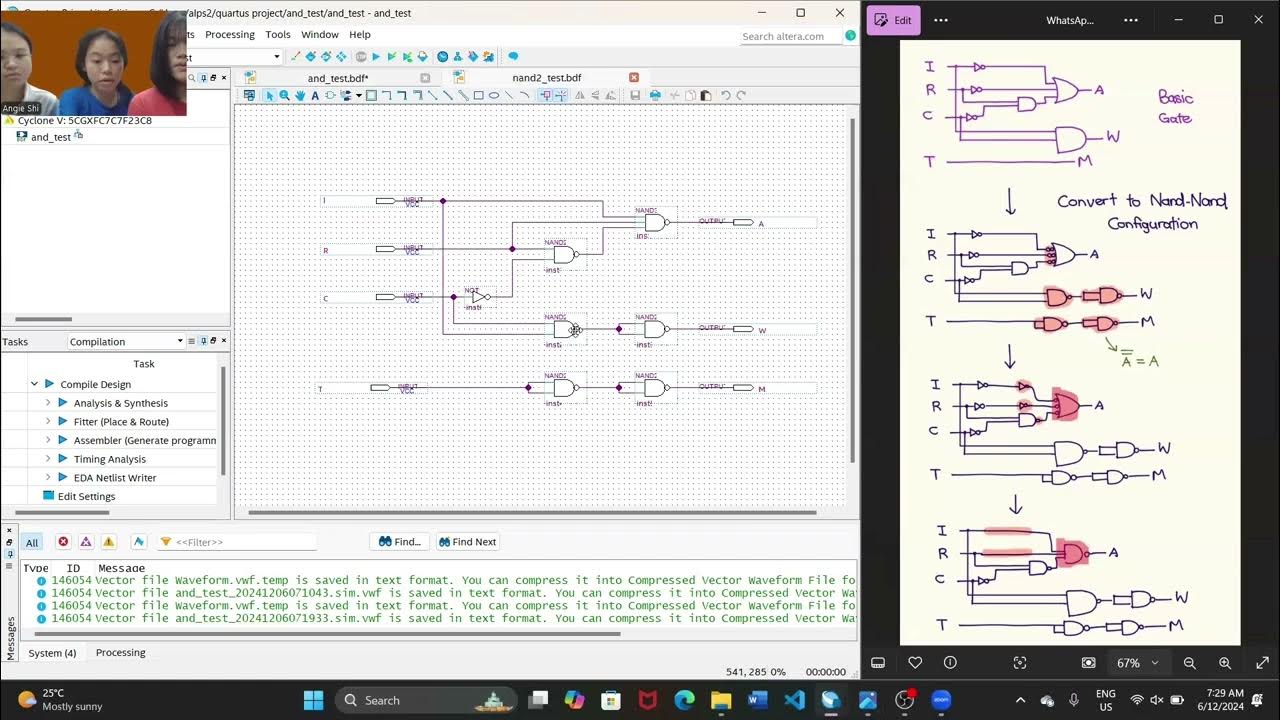Ejercicio de compuertas lógicas en protoboard, Alarma y Marcha de un automóvil
Summary
TLDRThis transcript describes a detailed process for designing a car alarm and safety system using logical gates. The system involves various conditions, including the car being turned on, seat belts not being fastened, doors being open, and the parking brake not being engaged. Logical gates like AND, OR, and NOT are used to trigger the alarm and indicate safe conditions. The script goes through how these components are connected and how the system reacts in different scenarios, with visual cues like red and green LEDs indicating the alarm and safe status. The design is demonstrated on a protoboard.
Takeaways
- 😀 The vehicle alarm system is designed to trigger when specific conditions are met, such as the car being on and seatbelts not fastened.
- 😀 Logical gates like AND, OR, and NOT are used to create the conditions for activating the alarm or safe start signal.
- 😀 The system will trigger an alarm if any door is open while the car is turned on or if the parking brake is not engaged.
- 😀 A modification was introduced to make the alarm go off if the car is turned on and either the trunk or hood is open.
- 😀 The alarm system uses sensors for ignition (e), seatbelts (c1, c2), doors (p1, p2), parking brake (f), and trunk/hood (t, h).
- 😀 The AND gate is used to ensure that certain conditions, like the car being on and seatbelts not fastened, are met simultaneously.
- 😀 OR gates are used to trigger alarms when at least one of multiple conditions (e.g., door open, hood/trunk open) is true.
- 😀 NOT gates are used to negate conditions, such as ensuring the parking brake is engaged for the alarm to stay off.
- 😀 The diagram of the circuit is created using logical gates, and a physical setup is built on a protoboard with LEDs indicating alarm (red) or safe conditions (green).
- 😀 The Boolean expression for the alarm system is simplified into a formula using AND, OR, and NOT gates, providing a clear system logic for triggering alarms or safe signals.
Q & A
What is the purpose of the vehicle security system described in the script?
-The purpose of the vehicle security system is to activate an alarm when certain conditions are met, such as when the ignition is on and at least one occupant is not wearing their seatbelt, or when doors are open under specific conditions.
How does the system detect if an occupant is not wearing their seatbelt?
-The system detects if an occupant is not wearing their seatbelt by checking the status of both seatbelt inputs (C1 and C2). If either seatbelt is not fastened, the system triggers the alarm.
What happens when one of the vehicle doors is open and the ignition is on?
-When one of the doors is open and the ignition is on, the system triggers the alarm, indicating a potential security concern.
How does the system react when at least one door is open and the handbrake is not engaged?
-If at least one door is open and the handbrake is not engaged, the system detects this combination and activates the alarm to warn the driver of a potentially unsafe situation.
What modification was made to the system regarding the trunk or hood?
-The system was modified to activate the alarm when the ignition is on and either the trunk (cajuela) or the hood (cofre) is open. This ensures that the vehicle’s security system accounts for these additional vulnerabilities.
What logic gates are used to control the alarm system?
-The system utilizes AND, OR, and NOT logic gates to combine various conditions like ignition status, seatbelt usage, door status, and handbrake status to trigger the alarm appropriately.
How does the system ensure that the vehicle is in a safe condition to start?
-To ensure the vehicle is in a safe condition to start, the system checks that all alarm conditions are inactive (alarm signals are negated) and that the ignition is on. If these conditions are met, the system signals that it's safe to start the vehicle.
What happens when the ignition is turned on and no seatbelts are fastened?
-When the ignition is turned on and no seatbelts are fastened, the system triggers the alarm, alerting the driver to the unsafe condition.
What role do the LED lights play in the system?
-The LED lights play a signaling role: the red LED indicates that the alarm is active, while the green LED signals that the vehicle is in a safe condition to start (when both seatbelts are fastened).
How is the function of the security system tested in the physical setup?
-The security system is tested in the physical setup by checking various conditions, such as turning on the ignition, fastening seatbelts, opening doors, and checking the trunk or hood. The system’s responses (alarm sound or signal change) are verified through these actions.
Outlines

This section is available to paid users only. Please upgrade to access this part.
Upgrade NowMindmap

This section is available to paid users only. Please upgrade to access this part.
Upgrade NowKeywords

This section is available to paid users only. Please upgrade to access this part.
Upgrade NowHighlights

This section is available to paid users only. Please upgrade to access this part.
Upgrade NowTranscripts

This section is available to paid users only. Please upgrade to access this part.
Upgrade NowBrowse More Related Video

Ep 027: Deriving a Truth Table from Combinational Logic

Ep 026: Introduction to Combinational Logic

MEMBUAT ALARM BANJIR SEDERHANA

Demonstration of combinational logic design using Quartus Prime software

Cara Memasang Alarm Mobil Universal pada Avanza 2008

BEST parking lot system | parking lot control system | Udemy Course project
5.0 / 5 (0 votes)